In today’s fast-paced manufacturing and distribution landscape, managing and publishing product information efficiently is no longer optional—it’s essential. As manufacturers expand their product ranges and operate across multiple sales channels, the demand for catalog automation has grown exponentially. The ability to streamline print and digital catalog publishing not only saves time but also ensures data consistency, brand uniformity, and faster time-to-market.
This comprehensive guide explores how catalog automation is transforming the manufacturing industry, the key benefits of automated catalog publishing, and how platforms like B2Sell Product Catalog Management Solutions empower businesses to achieve seamless automation across both digital and print workflows.
What is Catalog Automation?
Catalog automation is the process of using specialized software to automatically create, manage, and publish product catalogs using centralized product data. Instead of manually compiling spreadsheets, images, and descriptions, businesses can use catalog automation tools integrated with PIM (Product Information Management) or ERP systems to pull real-time product data and generate professional print or digital catalogs instantly.
Key Components of Catalog Automation:
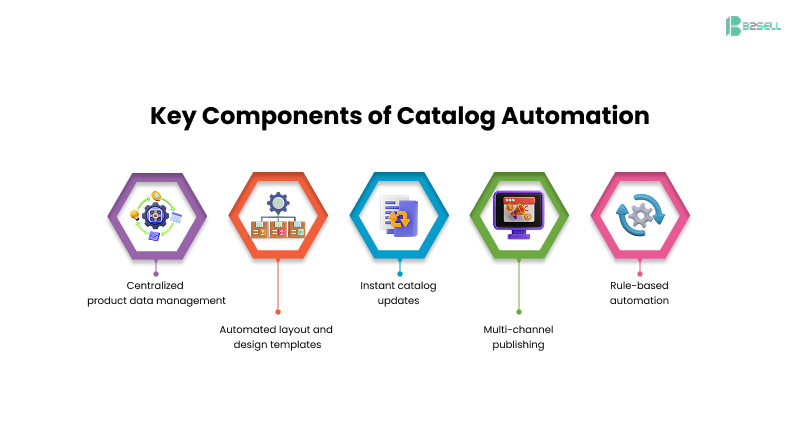
- Centralized product data management via PIM integration
- Automated layout and design templates for consistency
- Instant catalog updates when product data changes
- Multi-channel publishing (print, digital, web, and mobile)
- Rule-based automation for category grouping, pricing, and localization
By automating these processes, manufacturers can reduce human errors, accelerate time-to-market, and ensure every catalog — print or digital — reflects the most accurate and up-to-date information.
Why Manufacturers Need Catalog Automation
In the manufacturing sector, product lines evolve quickly. New SKUs, custom configurations, and pricing changes make manual catalog production inefficient. Catalog automation for manufacturers ensures operational agility and data consistency across channels.
Top Challenges Catalog Automation Solves:
- Manual Data Entry Errors – Eliminates inconsistencies in product descriptions and pricing.
- Time-Consuming Production – Reduces catalog creation time from weeks to hours.
- Brand Inconsistency – Maintains uniform design and layout across multiple catalogs.
- Complex Product Updates – Automatically syncs updates from ERP or PIM systems.
- Multi-Channel Management – Publishes both print and digital catalogs with one source of truth.
Automating catalog workflows enables teams to focus on product innovation and marketing instead of repetitive design and data-entry tasks.
Key Benefits of Automating Catalog Publishing
Implementing automated catalog publishing brings measurable business benefits:
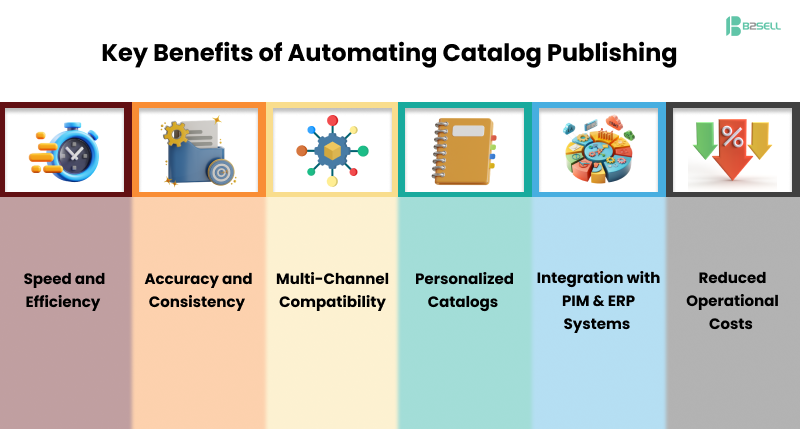
1. Speed and Efficiency
With automation, businesses can generate catalogs in hours instead of days. Frequent product updates no longer delay launches.
2. Accuracy and Consistency
Errors from manual entry are eliminated. Every catalog reflects the most current data pulled directly from your product information system.
3. Multi-Channel Compatibility
Create catalogs optimized for both digital and print use—ensuring consistency across your website, ecommerce store, and sales collateral.
4. Personalized Catalogs
Use product segmentation and rules to create customer-specific or region-specific catalogs automatically.
5. Integration with PIM & ERP Systems
Seamlessly integrate catalog automation software with PIM integration for unified data flow across platforms.
6. Reduced Operational Costs
Lower the need for manual design labor, third-party publishing fees, and long editing cycles.
How to Automate Product Catalogs for Manufacturing
To achieve maximum efficiency, follow these steps when implementing catalog automation for manufacturers:
- Centralize Product Data: Consolidate all product information in a PIM or ERP system.
- Choose Automation Software: Select a platform like B2Sell Product Catalog Management Solutions that supports both print and digital outputs.
- Design Modular Templates: Build reusable catalog templates with dynamic fields linked to product data.
- Map Data Fields: Connect product attributes (name, SKU, price, etc.) from your PIM to your template placeholders.
- Automate Publishing: Generate and export your catalog automatically for print or digital formats.
- Review and Distribute: Quickly review proofs, make data corrections in one place, and republish instantly.
Top Features of Modern Product Catalog Software
Modern product catalog software offers more than just automation—it provides complete data control and publishing flexibility.
Essential Features Include:
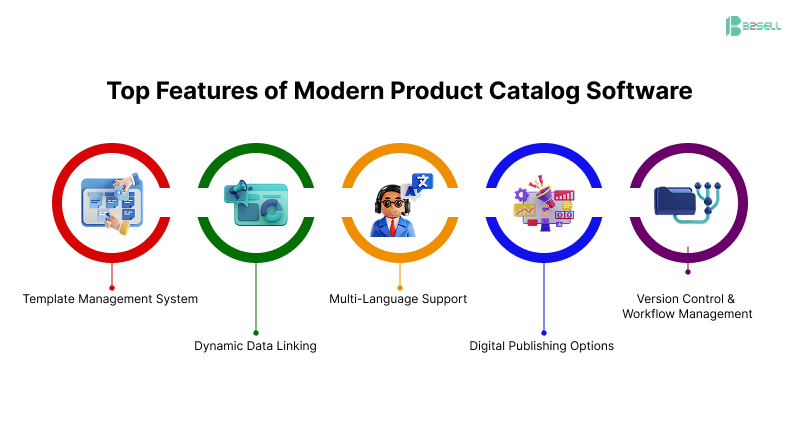
- Template Management System – Predefined design templates for catalogs, flyers, and brochures.
- Dynamic Data Linking – Real-time product data synchronization from your PIM or ERP.
- Multi-Language Support – Automatic catalog generation for different regions and languages.
- Digital Publishing Options – Create interactive PDFs and online flipbooks.
- Version Control & Workflow Management – Manage catalog versions and approval processes.
B2Sell’s product catalog management platform is specifically designed for manufacturers and distributors seeking full control over multi-channel publishing. B2Sell helps you publish accurate, visually consistent product catalogs faster — across print and digital — all from one connected source.
How Catalog Automation Works
Catalog automation integrates with your product data sources (like ERP or PIM systems) and uses smart templates to generate ready-to-publish catalogs. Here’s how it typically works:
- Data Centralization: All product information — SKUs, pricing, images, and attributes — are collected from a single database.
- Template Design: Designers create master templates that automatically adapt to different product categories and layouts.
- Automation Rules: Business rules define how data should be displayed — for example, grouping by product type or filtering by region.
- Automated Publishing: Catalogs are generated automatically in multiple formats (PDF, HTML, or InDesign).
- Instant Updates: Any change in product data is instantly reflected in future catalog versions.
This automation ensures real-time updates and eliminates the tedious back-and-forth between design, marketing, and product teams.
Print Catalog Automation vs Digital Catalog Creation
Both print catalog automation and digital catalog creation play essential roles in today’s hybrid B2B sales environment. Let’s explore their differences and how automation supports both.

With automated print production for distributors, manufacturers can easily maintain their traditional print catalog presence while expanding into digital-first experiences.
Best Catalog Automation Tools for B2B Businesses
When selecting the best catalog automation tools for B2B businesses, prioritize platforms that offer:
- Seamless integration with PIM/ERP systems
- Flexible publishing options (print, PDF, digital)
- Advanced filtering and data mapping
- Real-time data synchronization
- Cloud-based collaboration
B2Sell’s Product Catalog Management Solutions check all these boxes, making it an ideal choice for manufacturers aiming to streamline print and digital publishing.
The Future of Catalog Automation: AI and Personalization
AI is redefining how manufacturers handle product information and catalog creation. Through intelligent automation, AI-driven catalog tools can:
- Automatically detect incomplete product data.
- Suggest content improvements for better engagement.
- Generate AI-optimized catalog descriptions.
- Personalize digital catalogs based on buyer behavior.
The future of catalog automation software lies in combining human creativity with AI precision—something that B2Sell continues to advance.
Why Choose B2Sell for Product Catalog Automation
B2Sell Product Catalog Management Solutions simplifies catalog creation through automation, PIM integration, and AI-driven workflows.
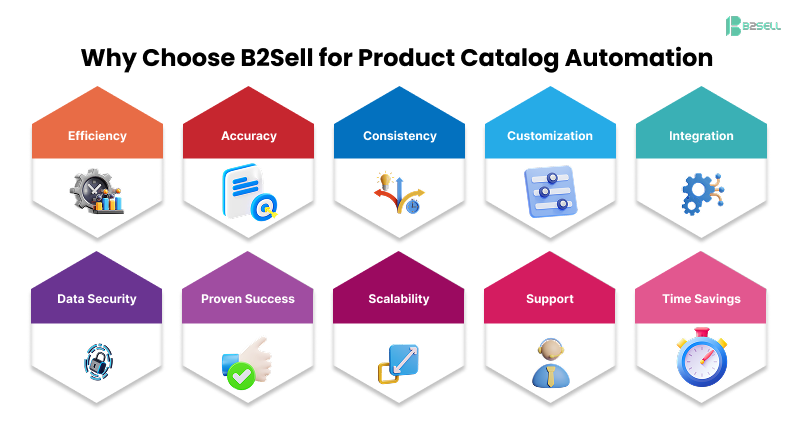
Efficiency
- Automatically generate and update catalogs without repetitive manual work, speeding up time-to-market.
Accuracy
- Pull product details directly from your ERP or PIM to eliminate data inconsistencies and reduce errors.
Consistency
- Use standardized templates and layouts to maintain a cohesive brand look across print and digital catalogs.
Customization
- Configure catalog formats, layouts, attributes, pricing, and language to fit your business workflows.
Integration
- Sync effortlessly with ERP, PIM, CRM, ecommerce platforms, and dealer portals for unified data and publishing.
Data Security
- Protect product information with secure access controls and encrypted data handling.
Proven Success
- Trusted by global B2B and B2C brands to manage large product catalogs at scale.
Scalability
- Grow without limitations—supports thousands of SKUs, multi-brand structures, and multi-region catalog variations.
Support
- Get expert onboarding, template setup assistance, and responsive help whenever needed.
Time Savings
- Significantly reduce catalog production time and focus your teams on sales and marketing, not formatting.
Whether you’re a manufacturer or distributor, B2Sell helps you move from manual catalog creation to a fully automated, data-driven publishing model.
FAQs: Catalog Automation for Manufacturers
What is the main benefit of catalog automation?
It drastically reduces manual work, ensuring faster and more accurate catalog creation across print and digital platforms.
Can catalog automation work with PIM or ERP systems?
Yes, most advanced solutions like B2Sell integrate directly with PIM, ERP, and ecommerce platforms for real-time updates.
How does automation help manufacturers scale?
By centralizing and automating product data distribution, manufacturers can easily create localized or customer-specific catalogs without rebuilding from scratch.
Can I create both print and digital catalogs automatically?
Absolutely. With B2Sell Product Catalog Management, you can produce both formats simultaneously using the same data source.
Conclusion: Empower Your Manufacturing Business with Catalog Automation
In an era of information overload, catalog automation isn’t just a convenience—it’s a strategic necessity for manufacturers who want to stay ahead. Automated solutions like B2Sell Product Catalog Management give you control, flexibility, and scalability to manage ever-growing product data across channels efficiently.
By adopting automated catalog publishing, you enhance customer experiences, ensure data accuracy, and accelerate your go-to-market strategy. Whether it’s print catalog automation or digital catalog creation, the future of manufacturing sales lies in seamless automation powered by B2Sell.
Explore the Future of Product Catalog Management
👉 Discover how B2Sell Product Catalog Management Solutions can help your business automate, publish, and grow faster with data-driven precision.

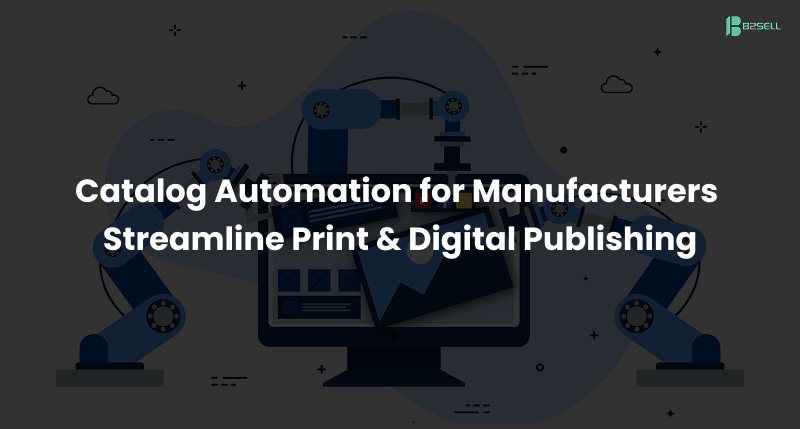
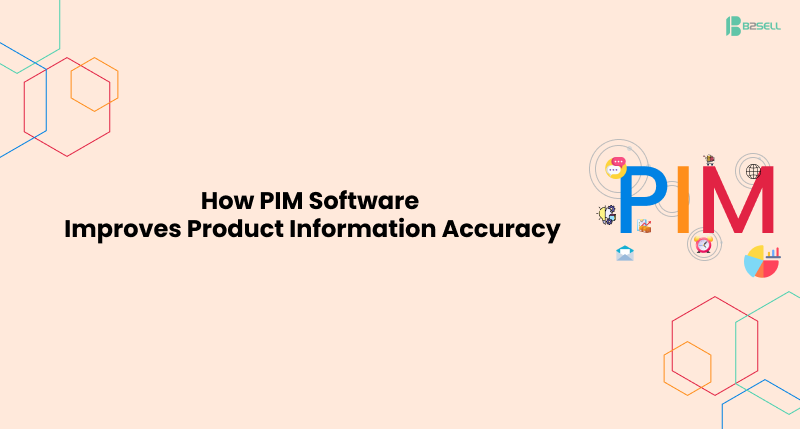
.png)


.png)